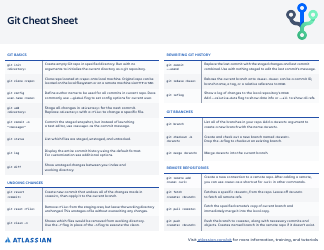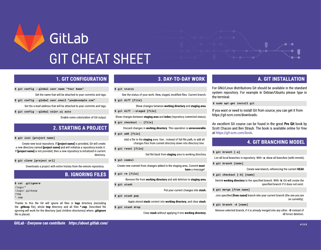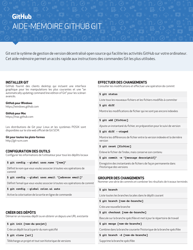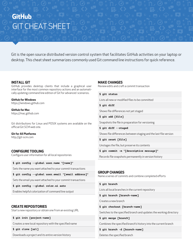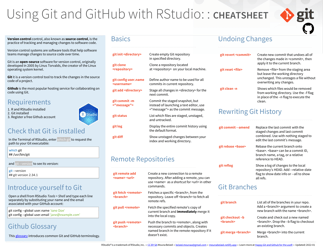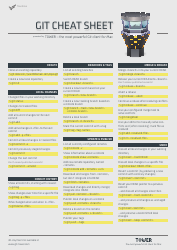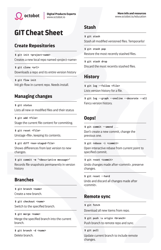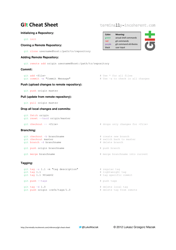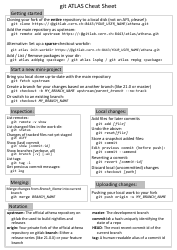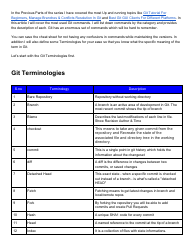Git Cheat Sheet - Blocks
Git Cheat Sheet - Blocks are a quick reference guide that provides helpful commands and tips for using Git, a version control system. It helps users remember and execute common Git commands efficiently.
FAQ
Q: What is Git?
A: Git is a distributed version control system that allows multiple people to collaborate on a project.
Q: How do I create a new Git repository?
A: You can create a new Git repository by using the 'git init' command.
Q: How do I clone an existing Git repository?
A: To clone an existing Git repository, use the 'git clone' command followed by the repository URL.
Q: How do I add files to the Git staging area?
A: You can add files to the Git staging area using the 'git add' command.
Q: What is the difference between 'git add .' and 'git add -A'?
A: 'git add .' adds all current directory files to the staging area, while 'git add -A' adds all files in the entire repository.
Q: How do I commit changes in Git?
A: To commit changes in Git, use the 'git commit' command followed by a commit message.
Q: How do I push my local Git commits to a remote repository?
A: You can push your local Git commits to a remote repository with the 'git push' command.
Q: How do I pull remote changes in Git?
A: To pull remote changes in Git, use the 'git pull' command.
Q: How do I create a new branch in Git?
A: To create a new branch in Git, use the 'git branch' command followed by the branch name.
Q: How do I switch between Git branches?
A: You can switch between Git branches using the 'git checkout' command followed by the branch name.
Q: How do I merge two Git branches?
A: To merge two Git branches, use the 'git merge' command followed by the branch name you want to merge into the current branch.
Q: How do I undo the last Git commit?
A: You can undo the last Git commit using the 'git reset' command followed by the commit hash.
Q: How do I view the Git commit history?
A: To view the Git commit history, use the 'git log' command.
Q: How do I discard changes in Git?
A: To discard changes in Git, use the 'git checkout' command followed by the file name you want to discard changes for.
Q: How do I create and apply Git patches?
A: To create a Git patch, use the 'git format-patch' command, and to apply a Git patch, use the 'git apply' command.
Q: What are Git aliases?
A: Git aliases are a way to create shortcuts for Git commands.
Q: How do I create a Git alias?
A: To create a Git alias, use the 'git config' command with the '--global' flag followed by the alias name and the command it should run.
Q: How do I list all Git aliases?
A: You can list all Git aliases using the 'git config --get-regexp alias' command.
Q: What is a Git remote?
A: A Git remote is a pointer to another repository that contains the same project.
Q: How do I add a Git remote?
A: To add a Git remote, use the 'git remote add' command followed by a remote name and the remote URL.
Q: How do I list all Git remotes?
A: You can list all Git remotes using the 'git remote -v' command.
Q: How do I remove a Git remote?
A: To remove a Git remote, use the 'git remote remove' command followed by the remote name.
Q: What is a Git branch?
A: A Git branch is a lightweight pointer to a specific commit.
Q: How do I list all Git branches?
A: You can list all Git branches using the 'git branch' command.
Q: How do I delete a Git branch?
A: To delete a Git branch, use the 'git branch -d' command followed by the branch name.
Q: What is a Git tag?
A: A Git tag is a way to bookmark a specific commit for future reference.
Q: How do I create a Git tag?
A: To create a Git tag, use the 'git tag' command followed by the tag name.
Q: How do I list all Git tags?
A: You can list all Git tags using the 'git tag' command.
Q: How do I delete a Git tag?
A: To delete a Git tag, use the 'git tag -d' command followed by the tag name.
Q: What is a Git stash?
A: A Git stash is a way to save changes that are not ready to be committed, allowing you to switch branches.
Q: How do I create a Git stash?
A: To create a Git stash, use the 'git stash save' command.
Q: How do I apply a Git stash?
A: To apply a Git stash, use the 'git stash apply' command.
Q: How do I list all Git stashes?
A: You can list all Git stashes using the 'git stash list' command.
Q: How do I delete a Git stash?
A: To delete a Git stash, use the 'git stash drop' command followed by the stash name.
Q: What is a Git submodule?
A: A Git submodule is a way to include a separate Git repository as a subdirectory within another Git repository.
Q: How do I add a Git submodule?
A: To add a Git submodule, use the 'git submodule add' command followed by the submodule URL and the path where it should be added.
Q: How do I update a Git submodule?
A: To update a Git submodule, use the 'git submodule update' command.
Q: How do I remove a Git submodule?
A: To remove a Git submodule, you need to manually delete the submodule folder and update the '.gitmodules' file.


